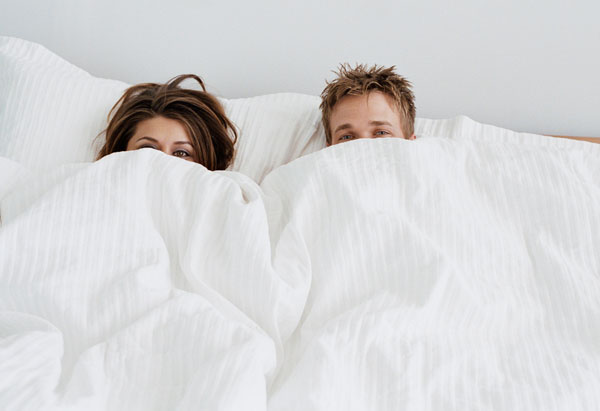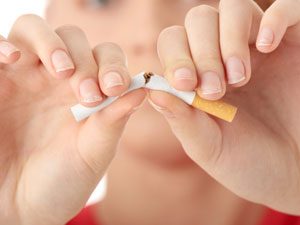Allow me to predict your future: At some point in the next year, a special person in your life—perhaps someone you married or birthed—will dump food all over your favorite sofa/carpet/chair. It's inevitable. But what if your favorite sofa/carpet/chair were stain-resistant, and you could simply swoop in with a rag and clean up the stain, leaving nary a trace? Here's your guide to preventing stains…or if it's too late, what to do once they hit.
Carpet
The deal: Carpets are designed to last 10 to 20 years—but many need to be replaced after 5 to 7 years due to staining. You can save bundles by planning ahead. Most new carpets (with the exception of all-natural fiber carpets, like wool) come coated with stain-resistant chemicals like Stainmaster or 3M Scotchgard—but no carpet is stainproof. Natural-fiber carpets aren't usually worth pretreating because their fibers are tight-knit and tend to repel stains better.
Don't! Ever use a carpet cleaner or stain fighter (such as vinegar, hydrogen peroxide, ammonia or nail polish remover) without testing it on a hidden corner first to make sure it doesn't fade the color. The last thing you need is a pale circle where the stain used to be. Photo by Alex Hayden/Getty Images.
Before the Stain Hits
Avoid white rugs. Yes, they look sleek and modern— but pretty soon they look like zebras, covered in smudges. White carpets are the equivalent of platinum blonde hair: a ton of work. If you have one, consider getting inexpensive throw rugs to put on top of highly trafficked areas. Also avoid black rugs, which are just like black cars—they show everything. Opt for light shades such as beige. That way, if you need to use spot remover, you run less of a risk of creating a pale spot on the rug than you would with a dark carpet.
Don't overclean. Four or five steam cleanings will remove your carpet's stain-resistant layer. Steam every few years as needed—but vacuum regularly, at least twice a month. And don't be shy about pulling out tarps or throw rugs when kids and dirty shoes are around. You may even want to…
Ban shoes. According to the EPA, dirt on our shoes can contain unhealthy elements, such as lead from outdoor paint, which then get deposited around the house. So go with bare feet or slippers only.
After the Stain Hits
Treat pronto. Once set, forever there. Blot the spot immediately, scrape up any solids, then flood the stain with water or club soda. Visit The Carpet and Rug Institute Spot Solver, which gives step-by-step instructions for cleaning up more than 100 different stains, from avocado to syrup. If it's ink, rearrange the furniture. Ink is nearly impossible to get out of carpets, as are nail polish and many cosmetics, because they soak into the fibers where otherwise trusty ink-stain removers like hairspray and glycerin can't get to them.
Be patient. Body fluids (urine, vomit, blood) do usually come out if treated promptly, but they often require soaking. If you have a mystery stain… Take time to figure out what it is. Ask everyone who might have been involved, and then visit the Spot Solver to plan your attack. If you're not sure, put warm water and dish soap in a bottle, shake it up and apply the foam to the stain. Then rinse with half water, half vinegar.
Walls
The deal: The most common kind of wall paint is latex-based, which comes in several sheens such as high-gloss and semigloss. (Oil-based paint is generally used for cabinets.) The most common and user-friendly sheens for kitchens and bathrooms are satin, semigloss and eggshell. These are easy to wipe clean: Stains come right off the protective shiny coating (the more sheen, the more stain-resistant it will be). The catch? Spot touch-ups are hard—you'll need to repaint the wall.
Flat paint is the darling of adults and designers because it gives walls texture and depth without reflecting every light in the room; however, it stains easily from grease, smoke or fingerprints. Given that, flat paints may not be the best choice for walls and are more often used on ceilings. Eggshell sheens, which are one step up in sheen from flat, are popular for bedrooms and dining rooms. Don't! Bother coating the walls with stain-resistant paints unless you're looking for a lacquered wall look. You don't need them, especially if you're using satin or eggshell paint. Photo by RUNSTUDIO/Getty Images.
Before the Stain Hits
Avoid very light colors. "Darker colors will show fewer smudges and marks," says Myron Latney, owner of The Paint Experts in Dallas.
Repaint. If you have light-colored eggshell or satin paint, you may want to spend the money to repaint the walls with primer first. "The primer prevents greasy fingerprints from penetrating the drywall and creating a permanent stain," says Latney. "It acts as a barrier." Then repaint with latex paint. And save some extra for next time.
After the Stain Hits
Treat quickly. If the stain sinks into the drywall, as is frequently the case with oil splatters behind the stove, it will be permanent. So act immediately.
Use dish soap and water. Stains on most wall paints will usually come right off. These paints are generally designed to withstand basic soap and water, so washing shouldn't leave a discoloration— but if you're concerned, test in a hidden corner.
Experiment. If that doesn't work, go for a stain remover. First, try baking soda applied with a damp sponge. Next, mix 1 part ammonia with 2 parts warm water and apply.
Prime, prime, prime! If you're going to paint over the stain, you'll likely have to repaint the whole wall unless you painted it in the last month or two. Make sure you prime directly over the stain. If it's an oilbased stain, use an oil-based primer. "That will prevent the stain from appearing through the new coat of paint," says Latney.
Consider hanging a strategically placed photo frame. Really. You don't necessarily have to remove the stain.
Sofas, Loveseats and Chairs
The deal: Most modern furniture upholstery comes soaked or dyed in stain-resistant chemicals. (See "A Word on 'Stain-Resistant,'" page 39.) There is generally no price difference between treated and untreated furniture, so ask the store or manufacturer what has been applied.
Don't! Dump water on your stain. You'll just end up with a water stain. If you have an overwhelming urge to try it, put a bit of water on a hidden corner, then wait an hour and see how it dries. Photo by Adam Gault/Getty Images.
Before the Stain Hits
Treat it. If your furniture hasn't yet been treated and you're comfortable with the chemicals, you can apply a product like Scotchgard. Treatment will make fabric slightly firmer. Natural fibers, like cotton, are easier to treat than silks or synthetics.
Slipcover it. Instead of investing in new furniture, keep what you have and buy washable slipcovers. Covers by Sure Fit work on lots of furniture shapes and come in a variety of fabrics, including suede and faux leather. ($25 to $150; SureFit.com)
Flip it. There's nothing wrong with having "good" and "stained" sides of the cushions. So have one side for everyday use, them flip the cushions whenever company's coming.
After the Stain Hits
Treat it. Attack it as you would a clothing stain, immediately. If your furniture is marked W, you can never go wrong by pouring club soda on a fresh stain to lift it from the material, while you run to your computer to figure out your next step.
Consider dry cleaning. Yes, you can take a whole cushion to the dry cleaner, and it will save you lots of grief.
REUPHOLSTER! "It makes me cringe when people say they won't get something beautiful until the kids grow up. It's always cheaper to reupholster a good quality piece, even a used one, than buy new," says Amy Estrin, owner of The Whole 9 Yards, a fabric interiors store in Portland, Oregon. Choose tough, tightly woven fabrics that you can apply a stain-resistant product to, such as tapestry or synthetic/ natural blends. "We have heavyduty, high-quality fabrics starting at $16.99 per yard," Estrin says.



































